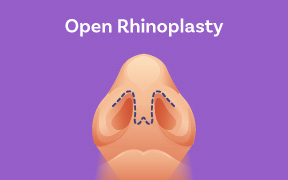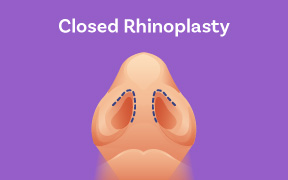
Select City
Enhance your facial harmony with personalised rhinoplasty at Pristyn Care. From nose reshaping and size reduction to correcting breathing issues with septorhinoplasty, we offer safe and advanced nose plastic surgery options. Consult experienced rhinoplasty doctors at Pristyn Care to refine your nose shape and improve both function and appearance with lasting results.
Enhance your facial harmony with personalised rhinoplasty at Pristyn Care. From nose reshaping ... Read More




Free Consultation

Free Cab Facility

No-Cost EMI

Support in Insurance Claim

1-day Hospitalization

USFDA-Approved Procedure
Choose Your City
It help us to find the best doctors near you.
Bangalore
Chennai
Coimbatore
Delhi
Hyderabad
Indore
Kochi
Kolkata
Mumbai
Pune
Vijayawada
Delhi
Gurgaon
Noida
Ahmedabad
Bangalore
Rhinoplasty is a surgical procedure often called nose reshaping or a nose job that changes the shape, size or proportions of the nose. You might choose rhinoplasty to:
The nose is composed of bone (upper part), cartilage (lower part) and skin. Rhinoplasty can modify any or all three components through procedures such as augmentation rhinoplasty, reduction rhinoplasty or septorhinoplasty.
• Disease name
Nose Reshaping Requirement
• Surgery name
Rhinoplasty
• Duration
1.5- 3 Hours
• Treated by
Plastic surgeon or cosmetic surgeon

Fill details to get actual cost
Rhinoplasty, also known as a nose reshaping or nose plastic surgery, can be classified into different types depending on the technique used and the reason for the procedure whether it is aesthetic, functional, or both.
Also known as external rhinoplasty, this method involves a small incision made in the columella (the tissue between the nostrils) to lift the nasal skin. This provides the surgeon full visibility of the nasal structure for precise reshaping.
It is usually recommended when:
While this technique may leave a tiny scar, it usually fades and becomes nearly invisible over time.
Also called endonasal rhinoplasty, this approach involves incisions made inside the nostrils, so there is no visible scarring.
It is ideal when:
Because it is less invasive, closed rhinoplasty often has shorter healing times but may not be suitable for more complex reshaping.
This focuses on improving the overall appearance of the nose while keeping it in balance with other facial features. It may involve:
Rhinoplasty is performed purely for aesthetic reasons but must still preserve normal breathing function.
This is carried out to correct structural defects and improve nasal airflow. It is recommended for:
In some cases, a rhinoseptoplasty or functional septorhinoplasty may be needed to combine cosmetic and medical goals in one procedure.
Before undergoing a rhinoplasty operation, it is important to follow a proper preparation plan to ensure safe surgery and effective results. Here is what to expect when preparing for nose reshaping surgery:
Your surgeon will start by reviewing your medical history. You will be asked about:
A thorough examination of your facial features and the inside and outside of your nose will be carried out.
This helps the surgeon assess:
In some cases, the surgeon may recommend imaging tests, such as CT (computerized tomography) scans or 3D imaging tests, to assess the nasal structure more accurately. These tests help to visualize the internal structure of the nose and aid in pre-operative planning.
Photographs of your nose will be taken from multiple angles. These images are used to:
An open and honest discussion will be held about:
If you are undergoing rhinoseptoplasty, both breathing function and appearance will be considered during this discussion.
Once the surgery is scheduled, your care team will guide you through preparation steps:
The surgery focuses on nose reshaping, which may involve changing the size, shape, angle, or structure of the nose to improve appearance and/or breathing.
You will receive anaesthesia to ensure comfort throughout the surgery. The type of anaesthesia depends on the complexity of the procedure and your medical needs:
The technique used during nose shape surgery depends on the treatment plan:
Once the incision is made:
Diet & Lifestyle Consultation
Post-Surgery Follow-Up
Free Cab Facility

24*7 Patient Support
Whether you have undergone cosmetic rhinoplasty, functional septorhinoplasty, or a rhinoseptoplasty, proper post-operative care is important for a smooth recovery and optimal results.
What to Expect Right After Surgery
Post-Surgery Instructions
To aid recovery and avoid complications after nose shape surgery, follow your surgeon’s advice carefully. This may include:
Additional Care Tips
Long-Term Healing
Like any surgical procedure, rhinoplasty carries certain risks. Our goal is to minimise these risks through advanced techniques and expert care, but it is important for patients to be fully informed before undergoing a rhinoplasty.
All types of surgery, including rhinoplasty and nose lift procedures, carry some general risks such as:
Risks specific to cosmetic rhinoplasty, functional septorhinoplasty, or combined rhinoseptoplasty surgeries may include:
While complications are rare, the possibility of further treatment or correction exists, especially in complex cases such as:
Rhinoplasty offers a range of cosmetic and functional benefits. Whether you are considering cosmetic rhinoplasty, septorhinoplasty, or rhinoseptoplasty, the procedure can significantly enhance both appearance and breathing. Here are the key benefits of rhinoplasty:
Rhinoplasty focuses on reshaping the nose for cosmetic reasons, while septoplasty corrects a deviated septum to improve breathing. A septorhinoplasty combines both procedures.
It is a specialised plastic surgery procedure that varies in complexity depending on the individual’s nose structure and goals.
Rhinoplasty is usually a day-care procedure. Most patients go home the same day after a few hours of observation.
Initial recovery takes about 1 to 2 weeks, but full healing and final nose shape may take several months.
Functional rhinoplasty or septorhinoplasty may be covered if it is done to treat breathing problems. Cosmetic rhinoplasty is usually not covered.
The cost of rhinoplasty in India usually ranges from ₹80,000 to ₹1,20,000. The final price may vary based on the type of procedure (such as cosmetic rhinoplasty or septorhinoplasty), the surgeon’s experience, and the hospital location.
Yes, digital imaging may be used to provide a visual estimate of the possible outcome based on your facial features.
Discomfort is common in the first few days, but pain is usually mild and managed with prescribed medication.
Nasal packing may be used temporarily in some cases to support healing and prevent bleeding, especially in septorhinoplasty procedures.
Bruising around the eyes typically lasts 1 to 2 weeks after surgery.
Choose an experienced, board-certified plastic surgeon who specialises in rhinoplasty and has a strong track record with procedures like closed rhinoplasty, nose straightening, and ethnic rhinoplasty.

Open Rhinoplasty
Also known as external rhinoplasty, this procedure involves making a small incision in the columella to separate the nostrils. Then the doctor gets access to the underlying bone and cartilage. As the entire structure is exposed during the procedure, the surgeon can reshape the framework with higher precision. The open technique is usually preferred when the patient’s nose is crooked or a marked reduction or enhancement needs to be done in the nasal tip. This approach may leave a scar behind but it usually fades away with time and becomes barely noticeable.

Closed Rhinoplasty
Also known as endonasal rhinoplasty, this surgery is more intricate as it is performed by making incisions inside the nostrils so that they are completely hidden. An incision is made in both left and right nostrils, and the changes in the shape and size are made with minimal complications. The closed technique is less invasive and causes no visible scarring.
Vikram
Recommends
Rhinoplasty was something I hesitated on for years. But the experience at La Midas was reassuring from day one. I love my new profile!
Harsh Das
Recommends
Dr. Pankhuri Garg is a true artist. My rhinoplasty looks subtle and refined, not overdone. I still look like me, just more confident.
Komal
Recommends
After years of insecurity, I finally got rhinoplasty. The subtle changes have made a big difference in how I see myself. So grateful for the care I received.
Riya Desai
Recommends
After years of dodging photos, I finally did something for myself rhinoplasty at Diyos. The change is subtle, yet it makes all the difference in how I feel.
Sneha Kumari
Recommends
I always felt self-conscious about the bump on my nose. Diyos gave me the confidence to go ahead with rhinoplasty, and I’m so glad I did.
Karan Mishra
Recommends
Was super nervous about getting a rhinoplasty, but the staff at Diyos made me feel comfortable from day one.
.svg)
.svg)